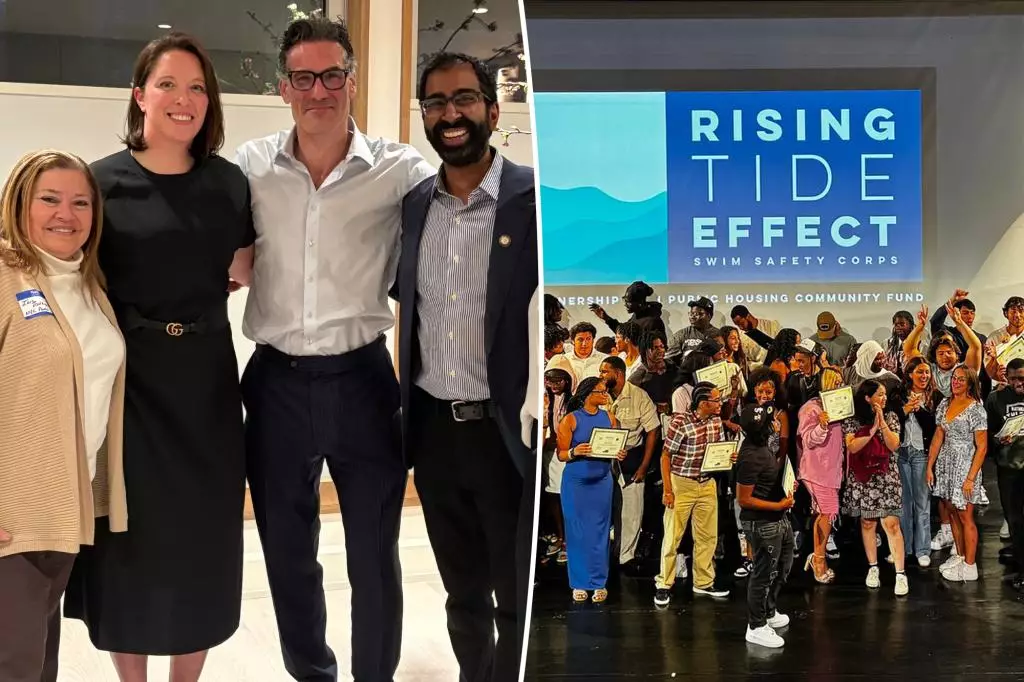With the approach of summer, a stark reality looms over New York City: the alarming trend of drowning incidents is higher than it has been for years. As the city anticipates the influx of beachgoers eager to enjoy the oceans and lakes, the urgency for comprehensive water safety education has never been more evident. The Rising Tide Effect, a non-profit founded by former competitive swimmer Kaitlin Krause, has taken it upon themselves to confront this issue head-on. Established in 2020, this organization aims to bridge the significant gap in water safety training among vulnerable populations, particularly those in underserved communities.
The statistics are sobering. Last year marked the highest drowning rate in NYC since 2019, with marginalized neighborhoods often bearing the brunt of these tragedies. The organization recognizes that access to swimming education is not uniformly distributed; in many areas, children and teenagers lack even the most basic familiarity with aquatic environments. This deficiency is not merely an inconvenience—it can be a matter of life and death.
Krause’s impassioned call to action during a recent gathering highlights the critical nature of their mission. “We need to ensure that access, safety, and joy in the water are possible for everyone,” she asserted, emphasizing the healing power of the water and the necessity of informed engagement with aquatic spaces. For many youth in the program, the astonishment of stepping into the ocean or swimming in a pool for the first time is a poignant reminder that water skills can unlock a world of experiences.
The Power of Community Engagement
Rising Tide Effect is more than just a water safety initiative; it is a community movement. Recently, supporters and community leaders gathered at a downtown home to rally behind Krause’s vision. Prominent figures like NYC’s First Deputy Parks Commissioner, Iris Rodriguez-Rosa, and Queens Council Member Shekar Krishnan underscored the importance of public engagement in this vital issue.
At the event, Krause eloquently addressed the systemic lack of water safety education as a significant contributor to the drownings prevalent in urban areas. She pointed out that understanding rip currents or potential hazards can save lives. “It’s about empowering our youth with knowledge,” she explained. “If they recognize the risks, they can make informed decisions about their safety.”
This summer, their campaign “Water Wise – Respect the Rip” is set to launch across buses, subways, and ferries. The goal is not just to raise awareness but to teach a culture of respect and caution when it comes to water activities. By transforming public spaces into platforms for education, Rising Tide Effect seeks to reframe how communities engage with aquatic environments.
Partnerships and Community Initiatives
The organization’s collaboration with local entities, like the Rockaway Hotel, illustrates a successful model of community partnership for effective outcomes. The hotel became a pivotal partner, utilizing its pool to offer safe swimming instruction before it even officially opened. This model serves as a beacon of hope, showing that local businesses can play a crucial role in solving community issues like drowning.
Michi Jigarjian, a member of Rising Tide Effect’s board, highlighted the devastating statistics of drownings in the Rockaways. By actively involving local resources, the program aims not just to teach swimming but to instill a sense of safety and community pride. The partnership framework allows for a broader outreach, enabling the initiative to expand into other neighborhoods and serve diverse populations.
While these community-driven efforts seek to teach swimming skills, they also address the social dynamics associated with water-related fear and embarrassment. Jon-Paul Rorech, the board chair, emphasized the organization’s mission extends beyond mere survival skills; it focuses on the holistic development of self-esteem and confidence among participants, turning fear into joy.
Legislative Support for Water Safety
The commitment to water safety also extends into the legislative arena, where discussions on formalizing water safety education in schools are gaining momentum. Council Member Krishnan has led initiatives in areas like Jackson Heights, advocating for access to public swimming facilities. His efforts to persuade private institutions to open their doors reflect the innovative thinking required to provide swimming education where it is needed most.
As access to public pools often remains limited in certain communities, initiatives like those championed by Krishnan might serve as stepping stones toward wider systemic reform. By bringing attention to the lack of resources and advocating for comprehensive policy changes, the movement towards ensuring equitable water safety education could gain traction.
The Rising Tide Effect symbolizes more than just a local initiative; it embodies the potential for societal change through education and community engagement. Water safety is not merely about preventing drownings; it’s about nurturing a generation that understands the water, respects it, and can navigate its challenges confidently. As the summer season approaches, the urgency of this mission remains a call to action for New Yorkers across all boroughs.

